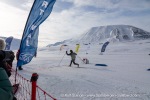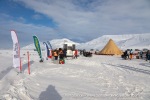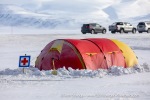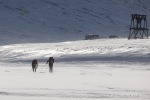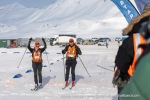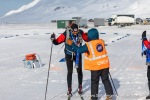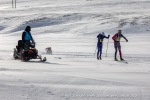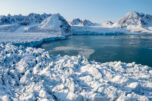-
current
recommendations- Liefdefjord
New page dedicated to one of Spitsbergen's most beautiful fjords. Background information and many photos.
- New Spitsbergen guidebook
The new edition of my Spitsbergen guidebook is out and available now!
- Liefdefjord
New page dedicated to one of Spitsbergen's most beautiful fjords. Background information and many photos.
Page Structure
-
Spitsbergen-News
- Select Month
- May 2025
- April 2025
- March 2025
- February 2025
- January 2025
- December 2024
- November 2024
- October 2024
- September 2024
- August 2024
- July 2024
- June 2024
- May 2024
- April 2024
- March 2024
- February 2024
- January 2024
- December 2023
- November 2023
- October 2023
- September 2023
- August 2023
- July 2023
- June 2023
- May 2023
- April 2023
- March 2023
- February 2023
- January 2023
- December 2022
- November 2022
- October 2022
- September 2022
- August 2022
- July 2022
- June 2022
- May 2022
- April 2022
- March 2022
- February 2022
- January 2022
- December 2021
- November 2021
- October 2021
- September 2021
- August 2021
- July 2021
- June 2021
- May 2021
- April 2021
- March 2021
- February 2021
- January 2021
- December 2020
- November 2020
- October 2020
- September 2020
- August 2020
- July 2020
- June 2020
- May 2020
- April 2020
- March 2020
- February 2020
- January 2020
- December 2019
- November 2019
- October 2019
- September 2019
- August 2019
- July 2019
- June 2019
- May 2019
- April 2019
- March 2019
- February 2019
- January 2019
- December 2018
- November 2018
- October 2018
- September 2018
- August 2018
- July 2018
- June 2018
- May 2018
- April 2018
- March 2018
- February 2018
- January 2018
- December 2017
- November 2017
- October 2017
- September 2017
- August 2017
- July 2017
- June 2017
- May 2017
- April 2017
- March 2017
- February 2017
- January 2017
- December 2016
- November 2016
- October 2016
- September 2016
- August 2016
- July 2016
- June 2016
- May 2016
- April 2016
- March 2016
- February 2016
- January 2016
- December 2015
- November 2015
- October 2015
- September 2015
- August 2015
- July 2015
- June 2015
- May 2015
- April 2015
- March 2015
- February 2015
- January 2015
- December 2014
- November 2014
- October 2014
- September 2014
- August 2014
- July 2014
- June 2014
- May 2014
- April 2014
- March 2014
- February 2014
- January 2014
- December 2013
- November 2013
- October 2013
- September 2013
- August 2013
- July 2013
- June 2013
- May 2013
- April 2013
- March 2013
- February 2013
- January 2013
- December 2012
- November 2012
- October 2012
- September 2012
- August 2012
- July 2012
- June 2012
- May 2012
- April 2012
- March 2012
- February 2012
- January 2012
- December 2011
- November 2011
- October 2011
- September 2011
- August 2011
- May 2011
- April 2011
- March 2011
- February 2011
- January 2011
- December 2010
- November 2010
- September 2010
- August 2010
- July 2010
- June 2010
- May 2010
- April 2010
- March 2010
- February 2010
- November 2009
- October 2009
- August 2009
- July 2009
- June 2009
- May 2009
- April 2009
- March 2009
- February 2009
- January 2009
- December 2008
- November 2008
- October 2008
- August 2008
- July 2008
- June 2008
- May 2008
- April 2008
- March 2008
- February 2008
- April 2000
- Select Month
-
weather information
-
Newsletter

| Guidebook: Spitsbergen-Svalbard |
Home → April, 2024
Monthly Archives: April 2024 − News
Svalbard skimarathon in wind and cold
This year’s Svalbard Skimarathon went off Saturday morning. Strong wind made the race a challenge for the 648 participants and even threatened to burst the event: the weather service had issued an avalanche warning for the general area, and Todalen, the valley with the race track, is generally speaking an area where avalanches are known to occur.

The Svalbard skimarathon went on Saturday in Todalen under challenging conditions:
strong wind and -12 degrees centigrade.
Avalanche safety was taken care of by a team of specialists who surveyed the area just before the race by helicopter and on the ground, so the race could start with a delay of one hour. The range of participants included professionals such as the Norwegian Olympic champion Olaf Tufte, ambitious amateurs and families with children who could chose between half and full marathon.
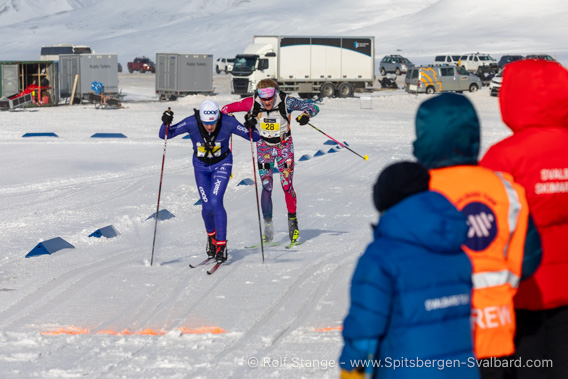
Full distance Winner Petter Soleng Skinstad with a time of 2:19:11, followed by Eivind Vold.
For all of them the race was a significant challenge, considering the arctic weather conditions and 400 metres of altitude that had to be covered up and down.
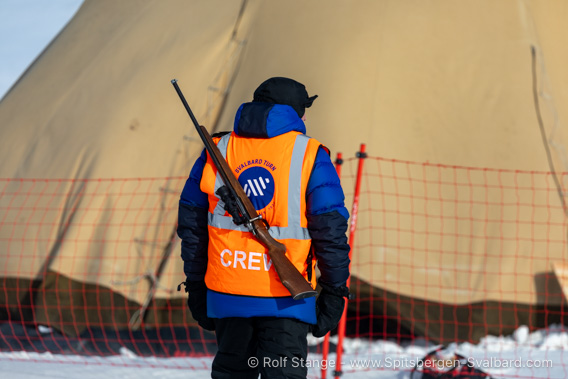
At any other marathon elsewhere, this would immediately have caused a major police operation. In this case, nobody paid any particular attention 🙂
Some more impressions from this year’s Svalbard skimarathon.
- gallery anchor link: #gallery_2983
Click on thumbnail to open an enlarged version of the specific photo.
Longyearbyen has got the power
Longyearbyen and its power: a never-ending story. This is not about higher powers, it is about electricity and long-distance heating. But this is enough to write a book about in this little town in Adventfjord (not for me as an author, thanks).
As visitors of this website will probably know (have a look here for a quick refresher), Longyearbyen’s power supply was based on coal for more than a century. Last autumn, coal was replaced with diesel. This is a temporary solution only, the idea is to install something more environmentally friendly, ideally without CO2-emissions. But nobody knows what exactly this should be although it is a question that has been debated for years already. The idea of a nuclear power plant for this town with 2500 inhabitants has recently surfaced again in a letter to the editor of Svalbardposten, the local newspaper.
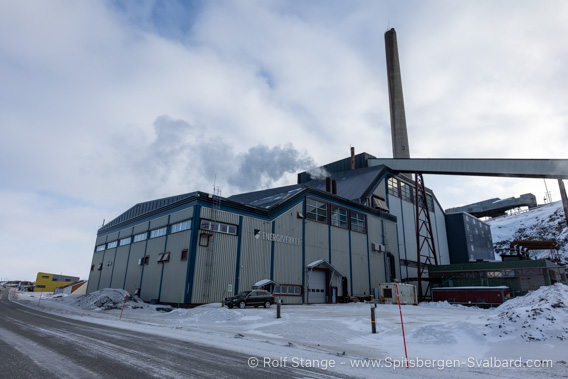
The Power plant in Longyearbyen supplies people with electricity, long-distance heating and conversation topics.
Technical issues and capacity worries
The operation of the new diesel generators, however, turned out to be anything but smooth. There have been technical issues more than once, including a havary of one of the engines that was similar to an explosion. One man got a good share of oil and engine parts from short distance. Luckily, he did not receive any serious injuries. Major customers who have got their own emergency power systems such as mine 7, the last coal mine near Longyearbyen still in operation, and KSat (the operator of the satellite antennas on Platåberg) have been asked to use their capacities to reduce the burden on Longyearbyen’s power plant.
Help from the Norwegian military
A few weeks ago, Sysselmester (governor) Lars Fause decided that Longyearbyen’s power supply system was not good enough, especially in these times of cold temperatures, and he asked the Norwegian military for help. They have capacities to set up a power supply system anywhere on short warning, and that is just what they did in Longyearbyen. The military generators now serve as a backup system in case the original system should experience major troubles, it is not intended to be used. But this is only a temporary backup and not a permanent solution.
The Norwegian airforce was heard saying that they could evacuate Longyearbyen quickly at any time if needed. This rather drastic measure could come into play in the event of a major interruption of Longyearbyen’s power supply, something that could quickly lead to a dangerous situation especially in the cold season. Temperatures have recently often been under -20°C, and most houses are poorly insulated. And almost all buildings in Longyearbyen rely on distant heating. A collapse of the distant heating system would soon seriously affect the water supply, which in itself is challenging enough even when heating and power are no problem. We have seen enough of that in recent weeks.
Price increase to be expected
Nobody knows for sure what Longyearbyen’s power supply of the future will look like. But there is little doubt that it will be expensive. Little Longyearbyen will hardly be able to pay the bill on its own and financial aid from Oslo is likely to play a major role. Nevertheless, an increase in prices is expected (they are talking about this while I am writing) – starting on a level that is already pretty high.
Diesel power plant without permission
To make things even “better”, the diesel power plant that is now in operation is running without the necessary permissions. The operator, a company owned by the community, appears to have assumed that the old license for the coal power plant would be sufficient also for the diesel generators, also based on the assumption that emissions would now be lower. There appears to be some uncertainty about wether or not this is actually the case, but higher authorities have now made it clear that the operation of the power plant requires permission which is not yet in place. At least, authorities have remarked that there is awareness of the importance of the power plant for Longyearbyen and a forced shutdown is not to be expected on short notice (but theoretically possible).

Longyearbyen’s power plant: “legalise it” 😅
With a subtle hint to an entirely different debate.
Photomontage by Wolfang Hübner-Zach, without any personal interest in the matter that is added to the original photo.
Ready for yet another fun fact? There was a diesel power plant in Sveagruva, the former mining settlement in Van Mijenfjord that has undergone a major cleanup in recent years. There are those who knew it and who say that it would have served Longyearbyen perfectly well.
The old Svea power plant has recently been turned into scrap metal.
At least the generators from Lunckefjellet, Sveagruva’s most recent mine that never entered the stage of productive production, are now envisaged to replace the above-mentioned military generators and serve as a backup for Longyearbyen’s main system.
New fish species found in Eskerdalen
Most people would probably not expect to find any fish at all in Spitsbergen’s rivers and lakes which are frozen most of the year. Arctic char is quite well known, a fish similar to salmon, and pink salmon, an invasive species that has arrived in Svalbard in recent years. Both are mainly found in larger lakes and laggons and rivers that connect these waters with the sea.
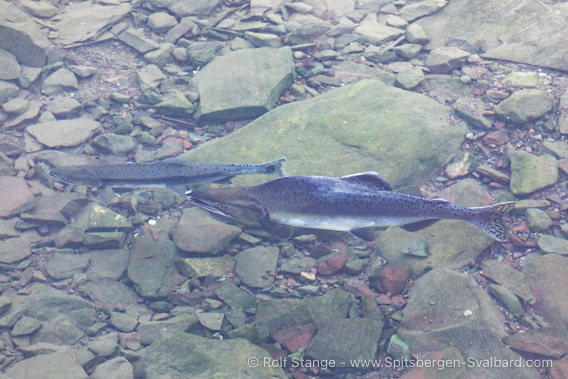
Fish in Spitsbergen’s rivers, arctic char and pink salmon.
If you do a trip to the east from Longyearbyen in the winter, for example to Tempelfjord or the east coast, you will pass a little waterfall in Eskerdalen, known as Eskerfossen. It is a popular place for a little rest.
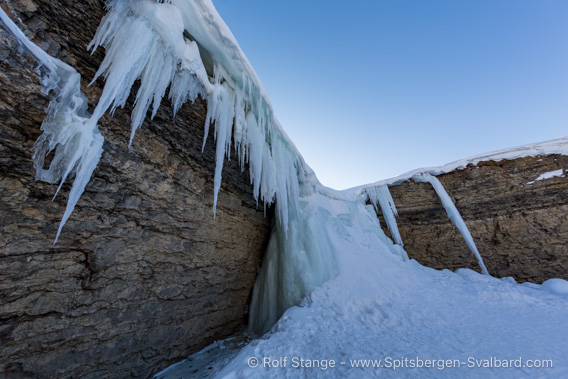
The waterfall Eskerfossen in winter.
Currently you can see something pretty unusual at Eskerfossen: there are several fishes in the mostly clear ice, just under the surface.

Eskerfossen with fishes.
It is not just the the view of fishes in the ice of a waterfall is more than just a little unusual. Beyond that, it is a species that is so far unknown from Spitsbergen’s waters.
Is it a new species? An invasive one, or was evolution incredibly fast this time? Is it connected to climate change? The Russians? Aliens? ..?
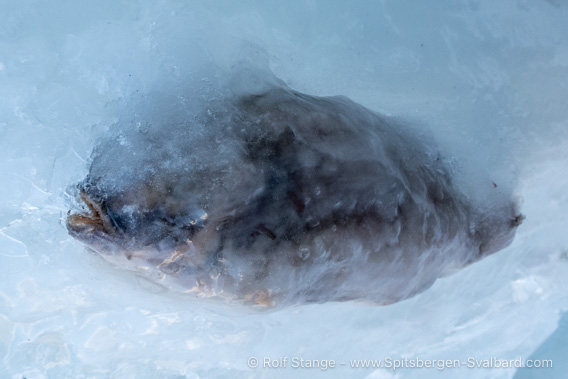
Fish in Eskerfossen. Image turned 90 degrees for easier viewing.
The answer to this problem is certainly much easier than that: this remarkable discovery was made on April 2, and it is well known which day comes before April 2.
It appears safe to assume that, other than Eskerfossen, the freezer in Svalbardbutikken (the supermarket) is most likely the only place where this species can be found in Svalbard 😄
With this slightly delayed April fool’s day joke (the original creator of which is unknown to me) I wish everybody a happy remaining April!
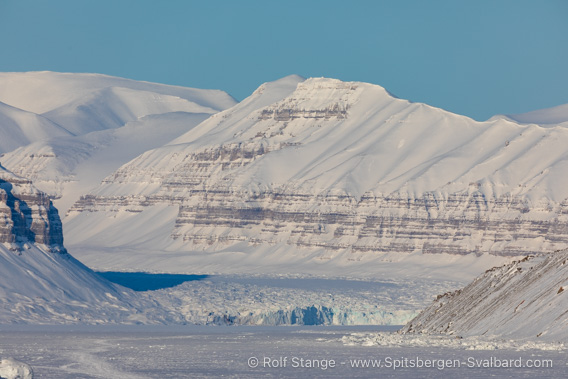
View into Tempelfjord from Fredheim, 12 km north of Eskerfossen.
News-Listing live generated at 2025/May/03 at 13:13:09 Uhr (GMT+1)

